
![Ver [Royal Council of the Orders of Chivalry] en instituciones citadas. Fortaleza de oro y mazonada de sable.](../css/Fortaleza.Institucion.png)
Royal Council of the Orders of Chivalry
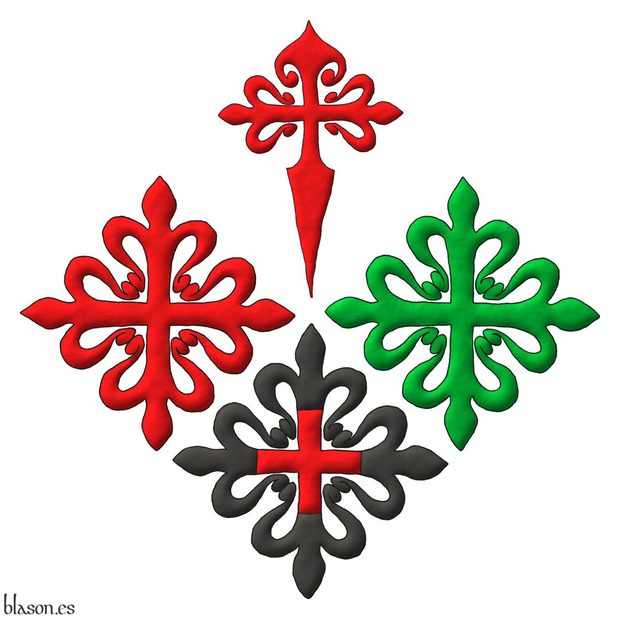
In 1523, the Order of Santiago, the Order of Calatrava, and the Order of Alcantara were definitively incorporated into the Crown of Castile, which marked the consolidation of the Royal Council of the Orders of Chivalry of Santiago, Calatrava, Alcantara, and Montesa. However, it is known that this Royal Council already existed at the beginning of the same 16th century, or even earlier, although there are no foundational documents available to date its inception.
The internet address of its website is ordenesmilitares.es where it also hosts the pages dedicated to each of its four orders:
- Order of Chivalry of Santiago: ordenesmilitares.es/orden-de-santiago.
- Order of Chivalry of Calatrava: ordenesmilitares.es/orden-de-calatrava.
- Order of Chivalry of Alcantara: ordenesmilitares.es/orden-de-alcantara.
- Order of Saint Mary of Montesa and Saint George of Alfama: ordenesmilitares.es/orden-de-montesa.
After the Crusades ended and following the model of the military orders created in the Holy Land, European kings established Orders of Chivalry, many of which were military and religious institutions, like the four grouped under this Royal Council.
Categories: Institution, Interpreted, Socioeconomic, Illuminated, Outlined in sable, Freehand, Emblem, Cross, Quarterly per saltire, Cross of Saint James, Cross couped, Cross of Calatrava, Cross of Alcantara and Cross of Montesa.


Royal Council of the Orders of Chivalry, emblem
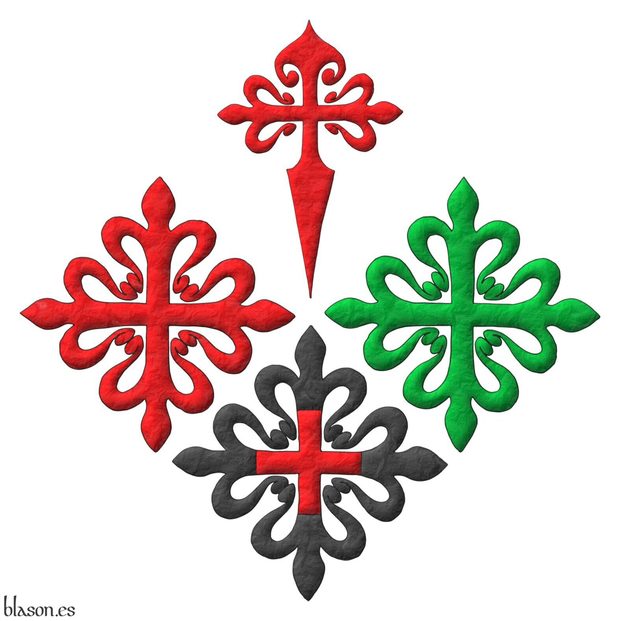
Royal Council of the Orders of Chivalry, of Santiago, Calatrava, Alcantara, and Montesa.
Emblem quarterly per saltire: 1, a cross of Saint James; 2, a cross of Calatrava; 3, a cross of Alcantara; 4, a cross of Montesa.
Emblema cuartelado en sotuer: 1o, una cruz de Santiago; 2o, una cruz de Calatrava; 3o, una cruz de Alcántara; 4o, una cruz de Montesa.
Interpretation of the emblem of the Royal Council with: its four crosses outlined in Sable, illuminated in Gules, Vert, and Sable; and a heavily hammered metal finish.
There is another version of this emblem of the Royal Council with the crosses of its four orders of Santiago, Calatrava, Alcantara, and Montesa outlined in Or instead of Sable.
Blazon keywords: Cross, Quarterly per saltire, Cross of Saint James, Cross couped, Cross of Calatrava, Cross of Alcantara and Cross of Montesa.
Style keywords: Illuminated, Outlined in sable and Freehand.
Classification: Interpreted, Socioeconomic and Emblem.
Bearer: Royal Council of the Orders of Chivalry.


![Ver [Santiago, Order of] en instituciones citadas. Fortaleza de oro y mazonada de sable.](../css/Fortaleza.Institucion.png)
Santiago, Order of
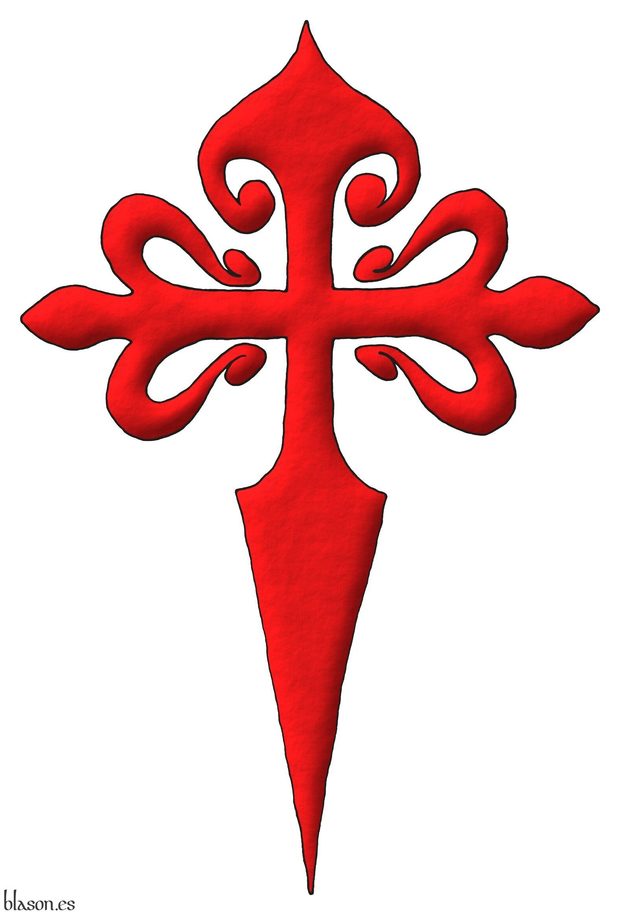
The Order of Chivalry of Santiago is both military and religious. It was founded in the Kingdom of León during the 12th century, although there is a difference of opinion regarding its exact year of foundation. It is named after the patron saint of Spain, James the Greater.
The purpose of its foundation was the protection of the Way of Saint James and the pilgrims who traveled it, and to participate militarily in the advancement of the reconquest of the Iberian Peninsula.
Of the Military Order of Santiago of the Sword, of its origin, and antiquity, as well as the form of its Commandery
[Avilés, J.; 1780b; treatise IV, chapter II, page 325] writes «The oldest authentic instrument that is found regarding the origin of the Order of Chivalry of Santiago of the Sword», observe how José de Avilés e Iturbide refers to the order in the masculine form, «is the donation made in the years of 848», note how the Marquess of Avilés does not doubt the antiquity of this order and even in other subsequent paragraphs, he dates it even earlier than currently believed, «made to the Church of Santiago by the King of León Don Ramiro in memory of the famous victory he achieved against the Moors in the battle of Clavijo (two leagues from Logroño), as evidenced by its Privilege, for having seen this Holy Apostle armed and mounted on a Horse, fighting in defense of the Christians; to whose devotion, and in this recognition, the said Order was instituted, taking from it its origin and name, as well as the same Cross that the Saint bore on his chest, and Shield, represented in the form of a Sword, of red color», gules ~ red, «for the blood shed of the Infidels, of whom Don Rodrigo Ximenez, Archbishop of Toledo, in his Chronicle Book VII says»: «Kubet ensis sanguine Arabum».
Drawing with a single stroke
Cross of Saint James the Greater drawing by me with a single stroke. This is the reason why it is asymmetrical, it has the base tip crooked, there are some sides higher than others, and it shows the failure of my pulse in a certains turns.
It is by far my most downloaded and copied painting, the most used on websites, citing me or not, the most used in hotels advertising, parish sheets... and even on T-shirts.
Categories: Institution, Interpreted, Religious, Military, Illuminated, Outlined in sable, Freehand, Emblem, Cross of Saint James, Cross couped and Cross.


Order of Santiago, emblem
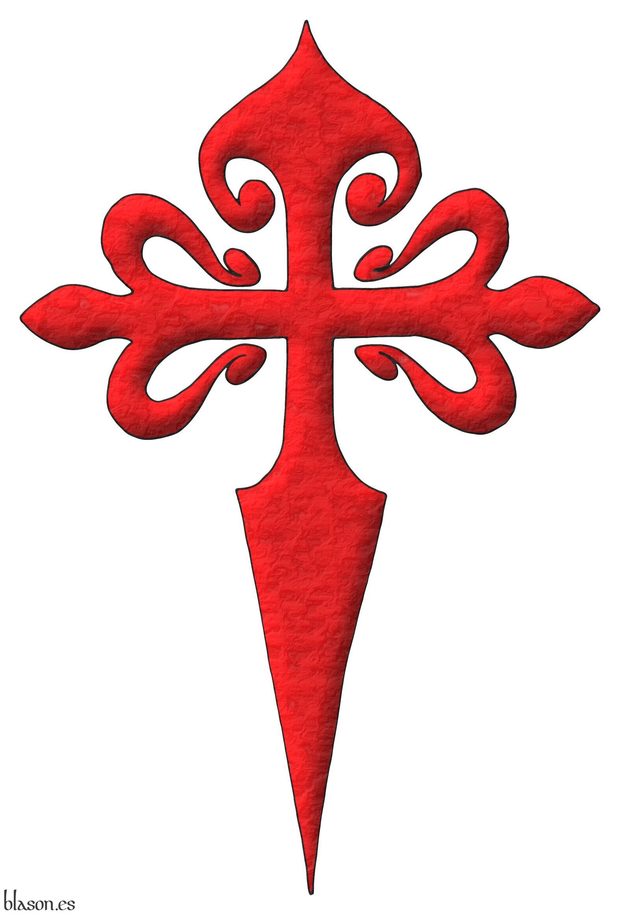
Order of Chivalry of Santiago
A cross of Saint James.
Una cruz de Santiago.
Interpretation of the emblem of the order with: its cross outlined in Sable, illuminated in Gules; and a heavily hammered metal finish.
The Royal Council of the Orders of Chivalry of Santiago, Calatrava, Alcantara, and Montesa, in its historical account of the foundation of the Order of Santiago, describes three different points of view:
- The one presented by tradition, which establishes it in 844, after the battle of Clavijo, when fourteen knights led by the Field Master Don Sancho Martínez de Tejada requested permission from Don Ramiro I, king of Asturias between the years 842 and 850, to found it. This traditional view is the one recorded in [Avilés, J.; 1780b; treatise IV, chapter II, page 325] when discussing the origin of the «Military Order of Santiago of the Sword».
- The perspective of historians like Claudio Sánchez Albornoz or Américo Castro, who question the earlier date. Furthermore, [Sánchez Albornoz, C.; 1965; pages 94-136], as cited in [Domínguez García, J.; 2008; pages 69-70], proposes that the actual battle of Clavijo occurred later, in the year 859, and that Ramiro I did not participate, but rather it was a conflict between King Ordoño I and the Moor Muza.
- The view of historians who, based on the statutes of the order found in the Monastery of Uclés, which was the residence of the Master of the Order of Santiago, and the Latin in which they are written, believe that the foundation could indeed date back to the reign of Don Ramiro I.
Emblem
Regarding the emblem of the Order of Chivalry of Santiago, [Avilés, J.; 1780b; treatise IV, chapter II, page 328, plate 25, figure 100] states «the Commandery of this Order was always a red Sword» (gules ~ red), «in the form of a Cross, just as the guards of the ancient Swords that its Knights and Commanders carried on their white Mantles, and today also on the chest in the same manner, hanging from a red ribbon on a gold medal; that is, in a field of Or, a Cross of Gules».
Blazon keywords: Cross of Saint James, Cross couped and Cross.
Style keywords: Illuminated, Outlined in sable and Soft metal.
Classification: Interpreted, Religious, Military and Emblem.
Bearer: Santiago, Order of.


![Ver [Calatrava, Order of] en instituciones citadas. Fortaleza de oro y mazonada de sable.](../css/Fortaleza.Institucion.png)
Calatrava, Order of
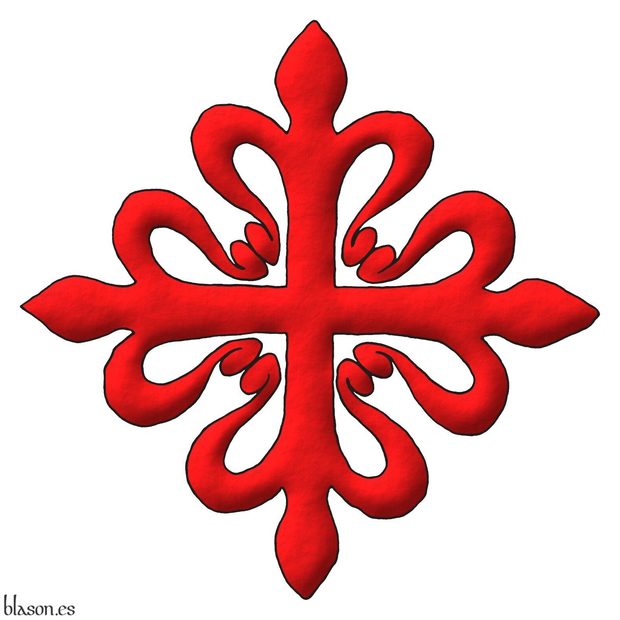
The Order of Chivalry of Calatrava is both military and religious, founded in the Kingdom of Castile during the 12th century by Abbot Raymond of Fitero.
The purpose of its foundation was the protection of the town of Calatrava la Vieja, which currently belongs to the municipality of Carrión de Calatrava in Ciudad Real. At the time of the order's foundation, it was an important city, in the middle valley of the river Guadiana and with a strategic position, as it was a necessary passage on the road from Toledo to Córdoba to Toledo and between the west and east of the Iberian Peninsula.
On the origin and antiquity of the Military Order of Calatrava, and the form of its Commandery
[Avilés, J.; 1780b; treatise IV, chapter IV, pages 334] writes «The Military Order of Calatrava was instituted by Don Sancho III, King of Castile (called the Desired), in the year 1158, while he was visiting his Kingdom; and being in Toledo with news of the great army that the Moors were gathering to besiege Calatrava la Vieja (which is called so today to distinguish it from the new one, which was founded later); and as the Templars, to whom this Fortress belonged, did not have sufficient power to resist such a large multitude, they handed it over to King Don Sancho himself so that he could take charge of it, as he did».
[Avilés, J.; 1780b; treatise IV, chapter IV, page 335] continues by telling us «The Abbot of Santa María de Fitero», near the river Pisuerga as he will indicate next, «of the Congregation of Cistercian, in the Bishopric of Palencia (which is a Monastery of St. Bernard, located on the river Pisuerga), named Don Raymond, and Friar Diego Velazquez, his subject Monk, who followed the Court, despite the difficulty of the enterprise, requested it from the King to defend it, which was granted, trusting in the virtue of the Abbot, and the strength of the Monk, who had previously been a great Knight in deeds of Arms, and very practiced in war».
[Avilés, J.; 1780b; treatise IV, chapter IV, page 336] continues «Seeing themselves in such an obligation, and that by themselves they could not fulfill it, they turned to Archbishop Don Juan (who was the fourth of Toledo) for help; and he, granting many indulgences in all his Archbishopric to those who, for themselves and for others, supplied the Place with provisions, in the same way as those who, unable to go due to old age or illness, helped with weapons, horses, and men; and having spread this news, so much help came to them, that when the Moors learned that the number of people exceeded twenty thousand men, they abandoned the conquest, returning to their homes: for this reason, the King ceded the Town of Calatrava to the Abbot of Fitero, and his successors, to defend it from the Moors from then on, confirmed later by King Alfonso IX, his son».
[Avilés, J.; 1780b; treatise IV, chapter IV, page 337] concludes «Having obtained this grace, Abbot Don Raymond brought the most suitable Monks from Fitero to Calatrava, and everything else that was necessary for living and for the defense of the Town and its land, which with the people inclined to war who remained, formed the Order of Chivalry of Calatrava, taking this name from the place where the institution was made, which in Arabic Calatrava means Castle».
Categories: Institution, Interpreted, Religious, Military, Illuminated, Outlined in sable, Freehand, Emblem, Cross of Calatrava, Cross couped and Cross.


Order of Calatrava, emblem
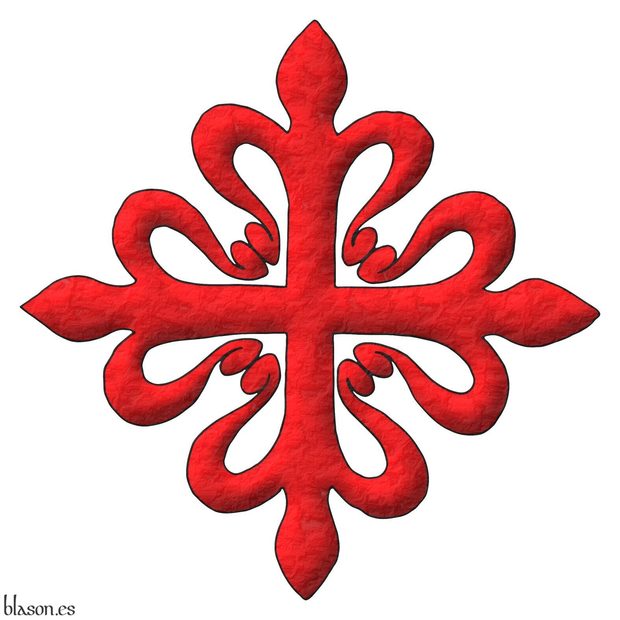
Order of Chivalry of Calatrava
A cross of Calatrava.
Una cruz de Calatrava.
Interpretation of the emblem of the order with: its cross outlined in Sable, illuminated in Gules; and a heavily beaten metal finish.
The Royal Council of the Orders of Chivalry of Santiago, Calatrava, Alcantara, and Montesa, in its historical review of the foundation of the Order of Calatrava, states that it was founded during the reign of Sancho III of Castile in the 12th century.
After the Templars withdrew from the defense of the town, King Sancho III proposed in Toledo and later confirmed in Almazán, in January 1158, the perpetual donation of the town of Calatrava to Raymond, then Abbot of the Cistercian monastery of Fitero, who, together with the former soldier Diego Velázquez, committed to defending it from attacks by the Almohads. For this mission, they received financial support from the Archbishop of Toledo, Juan, and from Toledo itself, thus managing to form an army of more than 20,000 men.
Emblem
Regarding the emblem of the Order of Chivalry of Calatrava [Avilés, J.; 1780b; treatise IV, chapter IV, page 338, figure 102] it states «the Seal was always a red cross with blue straps, and the Banner originally bore a black Cross; but today they use the red cross florety, bordered with eight circles, placed side by side, and joined at the center, formed by a cord that emerges from the leaves of the flower, which Benedict XIII gave (while recognized in Spain) and which is the Commandery that the Knights of this Order wear on their chest today, or hanging from a red ribbon on a gold medal; that is, on a field of Or a cross of Gules».
Blazon keywords: Cross of Calatrava, Cross couped and Cross.
Style keywords: Illuminated, Outlined in sable and Soft metal.
Classification: Interpreted, Religious, Military and Emblem.
Bearer: Calatrava, Order of.


Jamilena
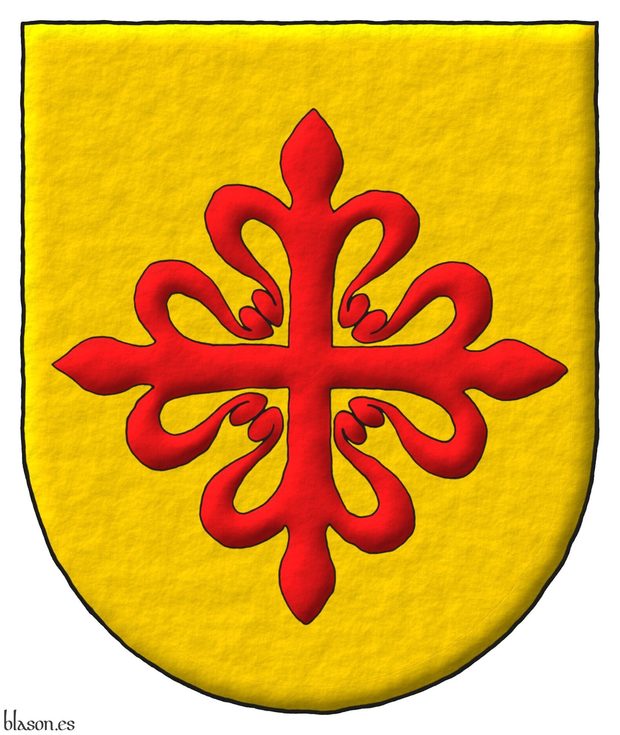
Coat of arms of the municipality of Jamilena, province of Jaén.
Or, a cross of Calatrava.
Escudo de oro, una cruz de Calatrava.
Coat of arms interpreted as follows: the shield's shape is a semicircular arch; the field is illuminated in metal Or; the cross of Calatrava is outlined in Sable and illuminated in Gules; and the entire piece has a rough line finish.
Blazon keywords: Without divisions, Or, Cross of Calatrava, Cross couped and Cross.
Style keywords: Semi-circular, Illuminated, Outlined in sable and Freehand.
Classification: Interpreted, Civic and Coat of arms.
Bearer: Jamilena.


Jamilena, province of Jaen
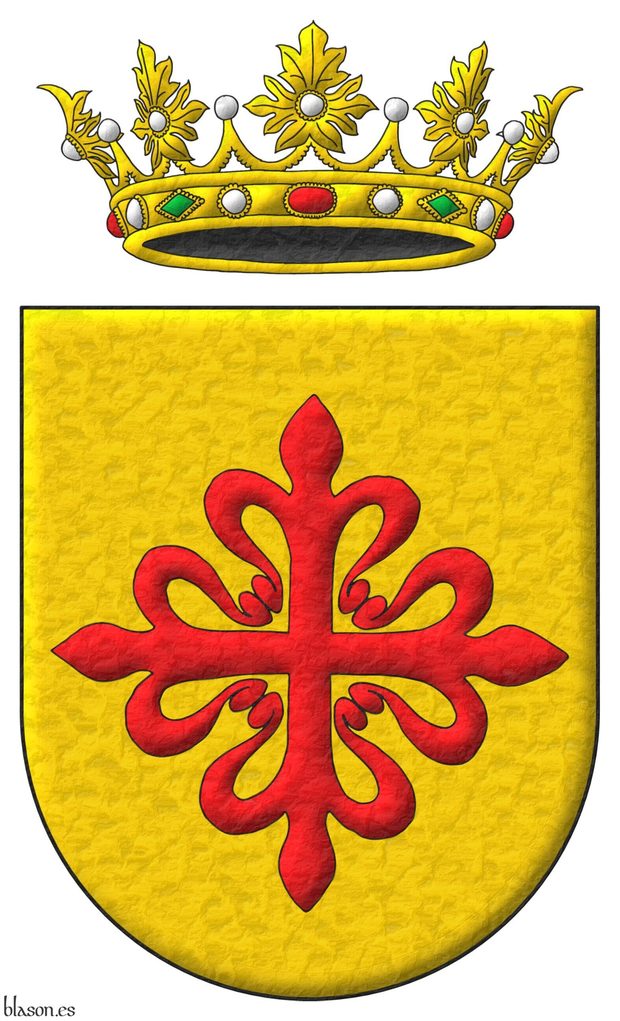
Or, a cross of Calatrava. Crest: An open royal crown Or.
Escudo de oro, una cruz de Calatrava. Timbrado de una corona real abierta.
Coat of arms interpreted as follows: the shield's shape is a semicircular arch; the field is illuminated in metal Or; the cross of Calatrava is outlined in Sable and illuminated in Gules; the royal crown is open, outlined in Sable and illuminated in metal Or, pearls in Argent, gemstones in Gules and Vert, and the visible base hollow in Sable; and the entire piece has a slightly hammered metal finish.
The municipality of Jamilena belongs to the La Campiña region and is the smallest in the province of Jaén. I have depicted its coat of arms with an open royal crown, but representations with a closed royal crown can also be found.
The origin of the cross of Calatrava in its heraldic coat of arms dates back to the year 1525 when Emperor Charles V issued several decrees from Toledo to build a convent for nuns in Jamilena. For the construction of this convent, stones from the Muslim castle, which was reformed and occupied by the Order of Calatrava, were used.
Blazon keywords: Without divisions, Or, Cross of Calatrava, Cross couped, Cross, Crest, Open royal crown and Crown.
Style keywords: Semi-circular, Illuminated, Outlined in sable and Soft metal.
Classification: Interpreted, Civic and Coat of arms.
Bearer: Jamilena.

Continue with: Alcantara, Order of.
-
Language
-
Categories of heraldry
-
Divisions of the field
- Without divisions
- Party per pale
- Party per fess
- Party per bend
- Party per bend sinister
- Tierce
- Tierce sinister
- Tierced per pale
- Tierced per fess
- Tierced per bend
- Tierced pallwise inverted
- Quarterly
- Quarterly per saltire
- Gyronny
- Party per fess, the chief per pale
- Party per pale, the sinister per fess
- Party per fess, the base per pale
- Party per pale, the dexter per fess
- Chapé
- Chaussé
- Embrassé
- Contre-embrassé
- Party per chevron
- Enté
- Enté en point
- Flanched
-
Metals
-
Colours
-
Furs
-
Other tinctures
-
Ordinaries and sub-ordinaries
-
Diminutives of the ordinaries
-
Other charges
-
Inanimate charges from Nature
Atom, Crescent, Diamond, Emerald, Estoile, Increscent, Lightning flash, Moon, Mount, Mullet, Mullet of four points, Orbital, Plough of Ursa Major, Rainbow, Ray of the sun, River, Sea, Snowflake, Sun, Sun in splendour, Sun of May, Trimount and Water.
-
Vegetal charges from Nature
Acorn, Apple, Apple tree, Ash, Bluebonnet, Camellia, Chrysanthemum, Cinquefoil, Cornflower, Dogwood flower, Double rose, Elm, Fleur de lis, Flower, Holm oak, Hop cone, Kapok tree, Laurel, Lily, Linden, Lotus flower, Madonna lily, Oak, Olive tree, Palm tree, Pomegranate, Poplar leaf, Rose, Shamrock, Sunflower, Thistle, Tree, Tulip, Vine and Wheat.
-
Animal charges from Nature
Badger, Bald eagle, Barbel, Barn owl, Bear, Beaver, Beetle, Bighorn sheep, Blackbird, Boar, Brach hound, Bull, Doe, Dog, Dolphin, Dove, Eagle, Elephant, Falcon, Fish, Flame, Fly, Fox, Frog, Goat, Goldfinch, Goose, Heron, Horse, Hummingbird, Jaguar, Lark, Leopard, Lion, Lion passant, Lion rampant guardant, Lioness, Lynx, Male figure, Martlet, Merino ram, Owl, Panther, Parrot, Peacock, Pelican, Pelican in her piety, Puffin, Quetzal, Raven, Roe deer, Rooster, Savage, Seagull, Serpent, She-wolf, Stag, Starling, Tyger, Vulture, Warren hound and Wolf.
-
Parts of natural charges
Arm, Beak, Branch, Caboshed, Chest, Claw, Covert, Dorsal fin, Eagle claw, Ermine spot, Escallop, Feather, Foot (palmiped), Foreleg, Forepaw, Hand, Head, Heart, Hoof, Leaf, Neck, Ostrich feather, Palm frond, Paw, Roe deers' attires, Shoulder, Sprig, Stags' attires, Stem, Swallow-tail, Tail, Tail addorsed, Tail fin, Talon, Tooth, Trunk, Trunk (elephant), Two hands clasped, Two wings in vol, Udder, Wheat spike, Wing and Wrist.
-
Artificial charges
Ace of spades, Anchor, Anvil, Arch, Arm vambraced, Armillary sphere, Arrow, Axe, Bell, Bell tower, Beret, Bonfire, Book, Bookmark, Bow, Bridge, Broken, Buckle, Cannon, Cannon dismounted, Cannon port, Carbuncle, Castle, Celtic Trinity knot, Chain, Chess rooks, Church, Clarion, Clay pot, Closed book, Club, Comb, Compass rose, Conductor's baton, Cord, Covered cup, Crozier, Crucible, Cuffed, Cup, Cyclamor, Dagger, Double vajra, Drum, Ecclesiastical cap, Fanon, Federschwert, Fleam, Four crescents joined millsailwise, Galician granary, Garb, Gauntlet, Geometric solid, Grenade, Halberd, Hammer, Harp, Host, Hourglass, Key, Key ward, Knight, Knot, Lantern, Letter, Line, Loincloth, Menorah, Millrind, Millstone, Millwheel, Monstrance, Mortar, Mullet of six points pierced, Nail, Non-classic artifact, Norman ship, Number, Oar, Oil lamp, Open book, Page, Pair of scales, Parchment, Pestle, Piano, Plough share, Polish winged hussar, Port, Portcullis, Potent, Quill, Ribbon, Rosette of acanthus leaves, Sabre, Sackbut, Sail, Scroll, Scythe, Sheaf of tobacco, Ship, Skirt, Spear, Spear's head, Stairway, Star of David, Step, Sword, Symbol, Tetrahedron, Torch, Tower, Trident, Trumpet, Turret, Two-handed sword, Wagon-wheel, Water-bouget, Wheel, Winnowing fan and With a turret.
-
Immaterial charges
Angel, Archangel, Basilisk, Dragon, Dragon's head, Garuda, Golden fleece, Griffin, Heart enflamed, Mermaid, Our Lady of Mercy, Ouroboros, Paschal lamb, Pegasus, Phoenix, Sacred Heart of Jesus, Saint George, Sea-griffin, Trinity, Triton, Unicorn, Winged hand and Wyvern.
-
External elements
-
Heraldic creations
-
References
-
Formats
-
Keywords on this page
Alcantara, Order of, Calatrava, Order of, Crest, Crown, Open royal crown, Cross, Cross of Alcantara, Cross of Calatrava, Cross of Montesa, Cross of Saint James, Cross couped, Quarterly per saltire, Outlined in sable, Emblem, Coat of arms, Illuminated, Institution, Interpreted, Jamilena, Semi-circular, Soft metal, Military, Or, Without divisions, Civic, Religious, Royal Council of the Orders of Chivalry, Santiago, Order of, Socioeconomic and Freehand.